What We’re Reading: December 8th
Commentary: The next generation of training for Arabidopsis researchers: Bioinformatics and quantitative biology
 Friesner and 38 other authors have written a Commentary outlining the need to radically redesign training for plant scientists to prepare for the massive production of biological data. They recommend a comprehensive revision of how we train undergraduate through post-docs, as well as opportunities for current faculty to acquire training. (We asked three of the authors for more information about some of the proposed changes – read more here ). You can also contribute your thoughts in terms of best ways to train or retrain plant scientists for our big-data world here. (Summary by Mary Williams) Plant Physiol. 10.1104/pp.17.01490
Friesner and 38 other authors have written a Commentary outlining the need to radically redesign training for plant scientists to prepare for the massive production of biological data. They recommend a comprehensive revision of how we train undergraduate through post-docs, as well as opportunities for current faculty to acquire training. (We asked three of the authors for more information about some of the proposed changes – read more here ). You can also contribute your thoughts in terms of best ways to train or retrain plant scientists for our big-data world here. (Summary by Mary Williams) Plant Physiol. 10.1104/pp.17.01490
Update: Impacts of fluctuating light on crop performance
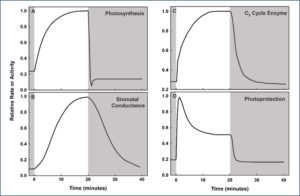 Light intensity varies seasonally, with time of day, with cloudiness, and as overlying leaves move in the wind. A sudden change in light intensity alters photosynthetic responses, but not all responses change at the same rate. For example, upon an increase in light intensity, photosynthetic electron transport can be upregulated more rapidly than stomatal conductance, affecting photosynthetic productivity. Sluggishness in stomatal closure in response to shade can adversely affect water-use efficiency. Slattery et al. explore how various facets affect photosynthesis in fluctuating light, and compare the impacts on C3 versus C4 plants. The “lagging response of photosynthesis to both increasing and decreasing light intensity… reveals opportunities for improving performance”, but more studies in natural, light-fluctuating environments are needed. (Summary by Mary Williams) Plant Physiol. 10.1104/pp.17.01234
Light intensity varies seasonally, with time of day, with cloudiness, and as overlying leaves move in the wind. A sudden change in light intensity alters photosynthetic responses, but not all responses change at the same rate. For example, upon an increase in light intensity, photosynthetic electron transport can be upregulated more rapidly than stomatal conductance, affecting photosynthetic productivity. Sluggishness in stomatal closure in response to shade can adversely affect water-use efficiency. Slattery et al. explore how various facets affect photosynthesis in fluctuating light, and compare the impacts on C3 versus C4 plants. The “lagging response of photosynthesis to both increasing and decreasing light intensity… reveals opportunities for improving performance”, but more studies in natural, light-fluctuating environments are needed. (Summary by Mary Williams) Plant Physiol. 10.1104/pp.17.01234
Letter: New database for metal and metalloid accumulating plants
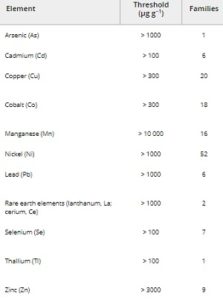 Plants that can accumulate metals or metalloids in their living tissues to extremely high levels (hyperaccumulators) can be used to model metal uptake and biotic interactions and used for phytoremediation, among other uses. While the uses for hyperaccumulators are vast, until now a database with global coverage of hyperaccumulators has been lacking. The new Global Hyperaccumulator Database (www.hyperaccumulators.org), under the administration of the Centre for Mined Land Rehabilitation of The University of Queensland (Brisbane, Australia), contains information about all known metal and metalloid hyperaccumulator species, including taxonomy, distribution, ecology, collection records, analytical data, and reference information. This database gathers data that is difficult to locate, provides information that has not been published in open literature, keeps nomenclature changes up to date and raises awareness of threatened hyperaccumulator species. As of July 2017, the database contains 721 species and continues to grow, as the discovery of hyperaccumulators is easier with new technologies. (Summary by Julia Miller) New Phytol. 10.1111/nph.14907
Plants that can accumulate metals or metalloids in their living tissues to extremely high levels (hyperaccumulators) can be used to model metal uptake and biotic interactions and used for phytoremediation, among other uses. While the uses for hyperaccumulators are vast, until now a database with global coverage of hyperaccumulators has been lacking. The new Global Hyperaccumulator Database (www.hyperaccumulators.org), under the administration of the Centre for Mined Land Rehabilitation of The University of Queensland (Brisbane, Australia), contains information about all known metal and metalloid hyperaccumulator species, including taxonomy, distribution, ecology, collection records, analytical data, and reference information. This database gathers data that is difficult to locate, provides information that has not been published in open literature, keeps nomenclature changes up to date and raises awareness of threatened hyperaccumulator species. As of July 2017, the database contains 721 species and continues to grow, as the discovery of hyperaccumulators is easier with new technologies. (Summary by Julia Miller) New Phytol. 10.1111/nph.14907
Review: Acid growth, an ongoing trip
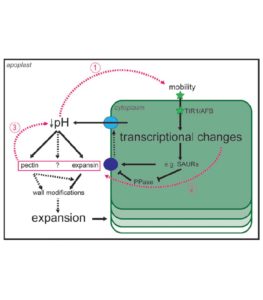
Plant growth is determined not only by cell division, but also by loosening of the cell wall. Arsuffi and Braybrook review our understanding of the mechanisms of cell wall loosening. Already in the 1970s scientists started to observe that low pH leads to increased growth, using destructive experiments. Although the effect of pH enhanced extensibility of effectively dead organs, RNA and protein synthesis were later identified to be important for effective cell wall loosening. Today we know that auxin induces apoplast acidification through phosphorylation of proton pumps at the plasma membrane. Modern fluorescent pH probes allow identification of the differences in apoplast acidification dynamics between hypocotyl and root during their growth. In the future, differences between species, feedback mechanisms and other wall modifying agents remain to be identified for their role in apoplast acidification and growth regulation. (Summary by Magdalena Julkowska) J. Exp. Bot 10.1093/jxb/erx390
Review: Emerging roles of cortical microtubule–membrane interactions ($)
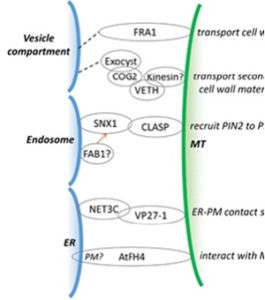 The plant cytoskeleton forms a dynamic and complex architecture in all plant cells and comes with a myriad number of functions, from allowing intracellular transport to regulating gene expression. In this review, Yoshihisa Oda focuses on the purposes of cortical microtubule (cMT) arrays, which are anchored to the plasma membrane and form highly-ordered structures. Oda goes beyond the conanical role of cMTs − cellulose synthase-complex movement along cMTs for cellulose microfibril deposition − and investigates what is known about the interaction of cMTs with various membrane structures. cMTs preferentially nucleate adjacent to preexisting cMTs to generate a branched or bundled network. This MT network typically forms a parallel array that connect to the plasma membrane and is maintained by such factors as Rho/Rac GTPase proteins (ROPs). On the other hand, in xylem vessel cells, ROP lateral diffusion is restricted by cMTs. In terms of abiotic stress, ABA treatment induces cMT disorganization, similarly seen during salt stress, in a manner involving the Arabidopsis phospholipase D isoform PLDα1. cMTs are also important for trafficking of non-cellulosic materials, as seen in newer studies investigating the kinesin FRAGILE FIBER1. Lastly, actin binding proteins and nucleating factors interact directly and indirectly to regulate cMT and ER dynamics. With advances in such tools as proteomic analysis and imaging techniques, cMT-membrane interactions will be easier to investigate and will facilitate our understanding of this process. (Summary by Alecia Biel) J. Plant Res. 10.1007/s10265.
The plant cytoskeleton forms a dynamic and complex architecture in all plant cells and comes with a myriad number of functions, from allowing intracellular transport to regulating gene expression. In this review, Yoshihisa Oda focuses on the purposes of cortical microtubule (cMT) arrays, which are anchored to the plasma membrane and form highly-ordered structures. Oda goes beyond the conanical role of cMTs − cellulose synthase-complex movement along cMTs for cellulose microfibril deposition − and investigates what is known about the interaction of cMTs with various membrane structures. cMTs preferentially nucleate adjacent to preexisting cMTs to generate a branched or bundled network. This MT network typically forms a parallel array that connect to the plasma membrane and is maintained by such factors as Rho/Rac GTPase proteins (ROPs). On the other hand, in xylem vessel cells, ROP lateral diffusion is restricted by cMTs. In terms of abiotic stress, ABA treatment induces cMT disorganization, similarly seen during salt stress, in a manner involving the Arabidopsis phospholipase D isoform PLDα1. cMTs are also important for trafficking of non-cellulosic materials, as seen in newer studies investigating the kinesin FRAGILE FIBER1. Lastly, actin binding proteins and nucleating factors interact directly and indirectly to regulate cMT and ER dynamics. With advances in such tools as proteomic analysis and imaging techniques, cMT-membrane interactions will be easier to investigate and will facilitate our understanding of this process. (Summary by Alecia Biel) J. Plant Res. 10.1007/s10265.
Review. Artificial evolution: Creating genetic diversity in the lab ($)
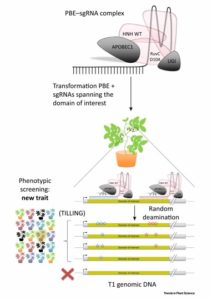 Humans have been domesticating plants for 10,000 years, having an impact on the gene pools of multiple species chiefly through selective breeding approaches. Although plant domestication ensured food availability to early civilizations, plants were, and still are, mainly selected based on their morphology and physiology, which include traits such as seed or fruit size, and timing of germination or ripening. Through generations of crops continuously selected for specific traits, much genetic variation has been lost in the offspring of these once wild and highly diverse species, making selecting for novel traits impossible. Fortunately, recent scientific advances have made editing and engineering plants easy and cost-effective. Unfortunately, transgenesis (introducing foreign DNA into a crop or organism of interest) faces much resistance and scrutiny. Alternatives are therefore required to enable new traits to be introduced into current crop species, or to improve wild species with potential for human use. The highly deliberated CRISPR-Cas technology makes fine, precise editing or silencing of DNA possible, but has its limitations when populations with a high-density of mutations are required, or to produce an array of possible phenotypes, for example to investigate how changes affect receptor sensitivity or enhance enzymatic activity. A recent article by Jacob and colleagues proposed a modified approach, using CRISPR technology and a newly designed chimeric nuclease enzyme. Their suggestion, called CREATE, allows for multiple mutations in close proximity to occur simultaneously. Through this method, a population highly saturated with a variety of mutations at a single locus can easily be generated, and individuals with phenotypes of interest rapidly identified. These technologies enable us to not only improve current crop species, but create new crops by engineering relevant traits in them. This truly is evolution in action. (Summary by Danielle Roodt Prinsloo) Trends Plant Sci. 10.1016/j.tplants.2017.10.002
Humans have been domesticating plants for 10,000 years, having an impact on the gene pools of multiple species chiefly through selective breeding approaches. Although plant domestication ensured food availability to early civilizations, plants were, and still are, mainly selected based on their morphology and physiology, which include traits such as seed or fruit size, and timing of germination or ripening. Through generations of crops continuously selected for specific traits, much genetic variation has been lost in the offspring of these once wild and highly diverse species, making selecting for novel traits impossible. Fortunately, recent scientific advances have made editing and engineering plants easy and cost-effective. Unfortunately, transgenesis (introducing foreign DNA into a crop or organism of interest) faces much resistance and scrutiny. Alternatives are therefore required to enable new traits to be introduced into current crop species, or to improve wild species with potential for human use. The highly deliberated CRISPR-Cas technology makes fine, precise editing or silencing of DNA possible, but has its limitations when populations with a high-density of mutations are required, or to produce an array of possible phenotypes, for example to investigate how changes affect receptor sensitivity or enhance enzymatic activity. A recent article by Jacob and colleagues proposed a modified approach, using CRISPR technology and a newly designed chimeric nuclease enzyme. Their suggestion, called CREATE, allows for multiple mutations in close proximity to occur simultaneously. Through this method, a population highly saturated with a variety of mutations at a single locus can easily be generated, and individuals with phenotypes of interest rapidly identified. These technologies enable us to not only improve current crop species, but create new crops by engineering relevant traits in them. This truly is evolution in action. (Summary by Danielle Roodt Prinsloo) Trends Plant Sci. 10.1016/j.tplants.2017.10.002
The plastid genome in Cladophorales green algae is encoded by hairpin chromosomes ($)
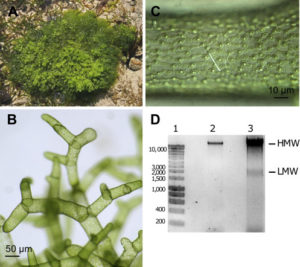 Plastids, the cellular sites for light reaction of photosynthesis, have a reduced genome which is circular and double stranded, ranging in the size from about 100 to 200 Kb. Some exceptions to this circular nature of plastid genomes are found in some groups of phytoplanktons, namely dinoflagellates, and as described in this work, Cladophorales green algae. Cortona et al. describe the highly divergent plastid genome of Boodlea composita which is entirely fragmented into hairpin chromosomes (single-stranded DNA folded back onto itself). The authors performed high-throughput short and long DNA and RNA sequencing, which resulted in a robust dataset of chloroplast protein-encoding genes on ~1 to 7 Kb DNA contigs with GC-enriched regions. The authors propose the contigs correspond to ssDNA that folds into hairpin chromosomes. Upon analysis of nine additional Cladophorales species, this fragmented chloroplast genome is seen to be a common feature of this group. (Summary by Amey Redkar) Curr Biol. 10.1016/j.cub.2017.11.004
Plastids, the cellular sites for light reaction of photosynthesis, have a reduced genome which is circular and double stranded, ranging in the size from about 100 to 200 Kb. Some exceptions to this circular nature of plastid genomes are found in some groups of phytoplanktons, namely dinoflagellates, and as described in this work, Cladophorales green algae. Cortona et al. describe the highly divergent plastid genome of Boodlea composita which is entirely fragmented into hairpin chromosomes (single-stranded DNA folded back onto itself). The authors performed high-throughput short and long DNA and RNA sequencing, which resulted in a robust dataset of chloroplast protein-encoding genes on ~1 to 7 Kb DNA contigs with GC-enriched regions. The authors propose the contigs correspond to ssDNA that folds into hairpin chromosomes. Upon analysis of nine additional Cladophorales species, this fragmented chloroplast genome is seen to be a common feature of this group. (Summary by Amey Redkar) Curr Biol. 10.1016/j.cub.2017.11.004
Intracellular distribution of manganese by NRAMP2 critical for photosynthesis and redox homeostasis
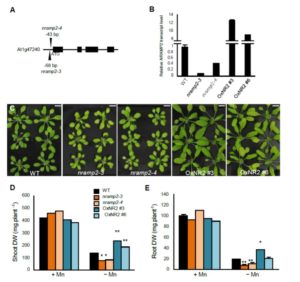 Manganese is a micronutrient essential for the function of several proteins including manganese superoxide dismutase (localized in the peroxisome and mitochondria) and the photosystem II reaction center (localized in the chloroplast). Mn is transported via NRAMP (Natural Resistance-Associated Macrophage Protein) transporters. Through reverse genetics and functional complementation of yeast mutants, Alejandro and Cailliatte et al. explore the contribution of NRAMP2 to Mn homeostasis. They show decreased Mn accumulation in organelles of nramp2 mutants, and that the NRAMP2 protein predominately accumulates in the trans-Golgi network. The authors speculate that the protein functions at an early cross-road of the Mn distribution pathway. (Summary by Mary Williams) Plant Cell 10.1105/tpc.17.00578
Manganese is a micronutrient essential for the function of several proteins including manganese superoxide dismutase (localized in the peroxisome and mitochondria) and the photosystem II reaction center (localized in the chloroplast). Mn is transported via NRAMP (Natural Resistance-Associated Macrophage Protein) transporters. Through reverse genetics and functional complementation of yeast mutants, Alejandro and Cailliatte et al. explore the contribution of NRAMP2 to Mn homeostasis. They show decreased Mn accumulation in organelles of nramp2 mutants, and that the NRAMP2 protein predominately accumulates in the trans-Golgi network. The authors speculate that the protein functions at an early cross-road of the Mn distribution pathway. (Summary by Mary Williams) Plant Cell 10.1105/tpc.17.00578
Increasing leaf vein density in rice results in an enhanced rate of photosynthesis
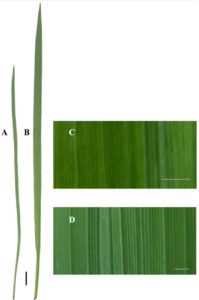 Increased leaf vein density is considered to be a key early step in the evolution of C4 photosynthesis. Feldman et al. analyzed five mutants with high vein densities in the C3 crop rice to determine if photosynthetic assimilation was improved. The mutants all had higher photosynthetic rates under saturating light, while not showing any characteristics of C4 photosynthesis. This potentially arose from an increase in the activation state of Rubisco, itself conferred by augmented hydraulic capacity. It is also possible that enhanced transport of photoassimilates plays in role in boosting photosynthesis in these mutants. (Summary by Mike Page) Front. Plant Sci. 10.3389/fpls.2017.01883
Increased leaf vein density is considered to be a key early step in the evolution of C4 photosynthesis. Feldman et al. analyzed five mutants with high vein densities in the C3 crop rice to determine if photosynthetic assimilation was improved. The mutants all had higher photosynthetic rates under saturating light, while not showing any characteristics of C4 photosynthesis. This potentially arose from an increase in the activation state of Rubisco, itself conferred by augmented hydraulic capacity. It is also possible that enhanced transport of photoassimilates plays in role in boosting photosynthesis in these mutants. (Summary by Mike Page) Front. Plant Sci. 10.3389/fpls.2017.01883
Patterns and consequences of subgenome differentiation provide insights into the nature of paleopolyploidy in plants
 Many plants are polyploid, meaning that instead of the normal, diploid “2n” complement of chromosomes (one from each parent), they have more than 2n. Following whole-genome duplication, redundancy can allow the duplicated regions to diverge or become silenced. In some cases, silencing occurs preferentially in one of the two parental genomes. By comparing the genomes of maize and soybean to their diploid relatives, Zhao et al. compared the consequences of (ancient) paleopolyploidy events in two species. They found that in maize, “one subgenome has been subject to relaxed selection, lower levels of gene expression, higher rates of transposable element accumulation and more small interfering RNAs and DNA methylation around genes, and higher rates of gene loss,” whereas although soybean does not exhibit subgenome dominance, “members of gene pairs do become differentiated, and that differentiation is associated with several of the same markers of differentiation that are observed in maize, including association with TEs, levels of gene expression and differences in selective constraints.” They propose that the differences observed are attributable to the fact that in maize the different parental genomes were more dissimilar than those in soybean. (Summary by Mary Williams) Plant Cell 10.1105/tpc.17.00595
Many plants are polyploid, meaning that instead of the normal, diploid “2n” complement of chromosomes (one from each parent), they have more than 2n. Following whole-genome duplication, redundancy can allow the duplicated regions to diverge or become silenced. In some cases, silencing occurs preferentially in one of the two parental genomes. By comparing the genomes of maize and soybean to their diploid relatives, Zhao et al. compared the consequences of (ancient) paleopolyploidy events in two species. They found that in maize, “one subgenome has been subject to relaxed selection, lower levels of gene expression, higher rates of transposable element accumulation and more small interfering RNAs and DNA methylation around genes, and higher rates of gene loss,” whereas although soybean does not exhibit subgenome dominance, “members of gene pairs do become differentiated, and that differentiation is associated with several of the same markers of differentiation that are observed in maize, including association with TEs, levels of gene expression and differences in selective constraints.” They propose that the differences observed are attributable to the fact that in maize the different parental genomes were more dissimilar than those in soybean. (Summary by Mary Williams) Plant Cell 10.1105/tpc.17.00595
Arabidopsis and crop plants differ in their 3D genome architecture ($)
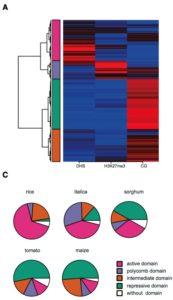 Three-dimensional organization of the genome is critical for proper gene expression. Comparison of the extremely compact genome of Arabidopsis with mammalian genomes revealed reduced local intra-chromosomal contacts (also know as Topologically Associated Domains, TADs) and fewer chromatin loops in the plant model. However, very little is known about spatial chromatin organization in plants with bigger and more complex genomes. In this study, Dong et al. provide the genome 3D architecture of five crop species (rice, sorghum, foxtail millet, tomato and maize). They identified in all five species large-scale euchromatic and heterochromatic compartments that can further be divided into local compartments based on their chromatin marks signature. Contrary to Arabidopsis and similar to mammals, crops exhibit obvious TAD-like domains, suggesting that local contacts are more frequent in large plant genomes. This is associated with an increase in long-range chromatin interactions through loops in the large tomato and maize genomes. This study highlights the complexity and the variety of 3D chromatin architecture in plants, and provides useful genomic and epigenomic resources for the community. (Summary by Matthias Benoit) Mol. Plant 10.1016/j.molp.2017.11.005
Three-dimensional organization of the genome is critical for proper gene expression. Comparison of the extremely compact genome of Arabidopsis with mammalian genomes revealed reduced local intra-chromosomal contacts (also know as Topologically Associated Domains, TADs) and fewer chromatin loops in the plant model. However, very little is known about spatial chromatin organization in plants with bigger and more complex genomes. In this study, Dong et al. provide the genome 3D architecture of five crop species (rice, sorghum, foxtail millet, tomato and maize). They identified in all five species large-scale euchromatic and heterochromatic compartments that can further be divided into local compartments based on their chromatin marks signature. Contrary to Arabidopsis and similar to mammals, crops exhibit obvious TAD-like domains, suggesting that local contacts are more frequent in large plant genomes. This is associated with an increase in long-range chromatin interactions through loops in the large tomato and maize genomes. This study highlights the complexity and the variety of 3D chromatin architecture in plants, and provides useful genomic and epigenomic resources for the community. (Summary by Matthias Benoit) Mol. Plant 10.1016/j.molp.2017.11.005
VERNALIZATION1 modulates root system architecture in wheat and barley

Root angle determines the rooting depth and was recently associated with the VERNALIZATION1 locus. Using hexaploid wheat, Voss-Fels et al. mapped the root angle to the locus encoding the MADS-box transcription factor, which was previously associated with flowering time. The group found that the lines carrying spring allele of VRN1 produced deeper roots and had a lower root-to-shoot ratio. The spring allele of VRN1 located on B-subgenome was found to have strongest phenotypic effect. The spring VRN1 in barley was also observed to enhance deeper root development, especially during the grain filling stage. At the whole root system level, VRN1 was observed to be independent of DEEPER-ROOTING1 and auxin signaling. The VRN1-dependent mechanisms that regulate above- and below-ground plant architecture remain to be identified in future studies. (Summary by Magdalena Julkowska). Mol. Plant 10.1016/j.molp.2017.10.005
Different gene expression patterns in Arabidopsis grown under different densities
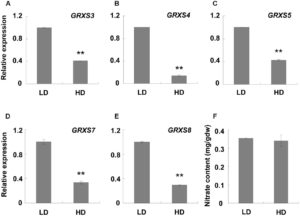 When grown at high density (HD), plants compete for nutrients, water and light. Guo and collaborators characterized Arabidopsis gene expression under two different growth densities: seeds sown at low density (LD), 10 cm apart and high density (HD), 2 cm apart. RNA sequencing analysis showed that only 205 of 20,660 genes were influenced by growth density. Genes in the category of amino acid metabolism, secondary metabolism and xenobiotic biodegradation were significantly affected. Also, the GRSX3/4/5/7/8 glutaredoxin genes were downregulated under HD. Previous studies showed that silencing of these genes produces a longer primary root in Arabidopsis and that an excess of nitrate induces expression of these genes. The authors concluded that HD can affect plant growth through a nitrate-limitation response. (Summary by Cecilia Vasquez ) Front. Plant Sci. 10.3389/fpls.2017.02001
When grown at high density (HD), plants compete for nutrients, water and light. Guo and collaborators characterized Arabidopsis gene expression under two different growth densities: seeds sown at low density (LD), 10 cm apart and high density (HD), 2 cm apart. RNA sequencing analysis showed that only 205 of 20,660 genes were influenced by growth density. Genes in the category of amino acid metabolism, secondary metabolism and xenobiotic biodegradation were significantly affected. Also, the GRSX3/4/5/7/8 glutaredoxin genes were downregulated under HD. Previous studies showed that silencing of these genes produces a longer primary root in Arabidopsis and that an excess of nitrate induces expression of these genes. The authors concluded that HD can affect plant growth through a nitrate-limitation response. (Summary by Cecilia Vasquez ) Front. Plant Sci. 10.3389/fpls.2017.02001
Dual impact of elevated temperature on plant defense and bacterial virulence in Arabidopsis
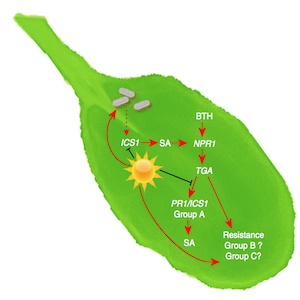 Huot et al. describe how elevated temperature (30 °C) enhances Arabidopsis thaliana disease susceptibility to the bacteria Pseudomonas syringae pv. tomato DC3000 (Pst DC3000): this includes an increase of bacterial type III secretion suggesting that increased Pst DC3000 virulence at 30°C is linked to increased translocation of bacterial effector proteins. The authors also found that enhanced disease susceptibility is independent of the phyB/PIF network which has previously been implicated in temperature sensing. Meanwhile the salicylic acid biosynthesis pathway is compromised at this elevated temperature, meaning that pathogen-induced salicylic acid production is a key temperature-vulnerable step in the defense network. Information gathered by Huot et al. might be useful for genetic manipulation of temperature-related genes of the plant immune system in order to enhance resilience to combined abiotic and biotic stress conditions in the today’s climate change scenario. (Summary by Isabel Mendoza) Nature Comms 10.1038/s41467-017-01674-2
Huot et al. describe how elevated temperature (30 °C) enhances Arabidopsis thaliana disease susceptibility to the bacteria Pseudomonas syringae pv. tomato DC3000 (Pst DC3000): this includes an increase of bacterial type III secretion suggesting that increased Pst DC3000 virulence at 30°C is linked to increased translocation of bacterial effector proteins. The authors also found that enhanced disease susceptibility is independent of the phyB/PIF network which has previously been implicated in temperature sensing. Meanwhile the salicylic acid biosynthesis pathway is compromised at this elevated temperature, meaning that pathogen-induced salicylic acid production is a key temperature-vulnerable step in the defense network. Information gathered by Huot et al. might be useful for genetic manipulation of temperature-related genes of the plant immune system in order to enhance resilience to combined abiotic and biotic stress conditions in the today’s climate change scenario. (Summary by Isabel Mendoza) Nature Comms 10.1038/s41467-017-01674-2
LYS12 LysM receptor decelerates Phytophthora palmivora disease progression in Lotus japonicus
 It might sound odd, but so far it was hard to find a nice pathogen infecting model legume plants. Fuechtbauer and colleagues showed the capacity of an oomycete (Phytophtora palmivora) to infect Lotus japonicus and describe how a LysM receptor, LYS12, is partly mediating this plant-microbe interaction. Usually, plant responses to pathogens depend on recognition of a pathogen-associated molecular pattern, such as chitin or flagellin. Interestingly Phytophtora palmivora does not present any detectable chitin monomer (in vitro or in infected roots) and therefore the authors speculate that LYS12 could mediate broad-spectrum plant immunity responses. (Summary by Marco Giovanetti) Plant J. 10.1111/tpj.13785
It might sound odd, but so far it was hard to find a nice pathogen infecting model legume plants. Fuechtbauer and colleagues showed the capacity of an oomycete (Phytophtora palmivora) to infect Lotus japonicus and describe how a LysM receptor, LYS12, is partly mediating this plant-microbe interaction. Usually, plant responses to pathogens depend on recognition of a pathogen-associated molecular pattern, such as chitin or flagellin. Interestingly Phytophtora palmivora does not present any detectable chitin monomer (in vitro or in infected roots) and therefore the authors speculate that LYS12 could mediate broad-spectrum plant immunity responses. (Summary by Marco Giovanetti) Plant J. 10.1111/tpj.13785
Sequestration and activation of plant toxins protect the western corn rootworm from enemies at multiple trophic levels
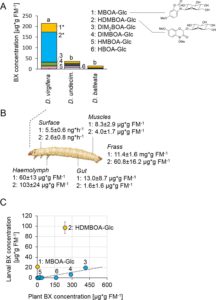 Plants are attacked by diverse herbivores but have also evolved strategies to resist them. However, highly adapted herbivores exist, including those that have evolved the ability to stabilize, sequester and reactivate plant toxins. This evolved trait has contributed to herbivore defense against higher trophic level enemies. A clear ecological significance of this interaction is shown in this recent work by Robert et al. in the western corn rootworm. The authors demonstrate that the western corn rootworm, an important maize pest, has an ability to accumulate the root-derived benzoxazinoid glucosides HDMBOA-Glc and MBOA-Glc. The herbivore stabilizes and sequesters the benzoxazinoid product MBOA making the insect highly resistant against attacking nematodes below-ground. Activation of the accumulated compound toxicity can be done by larvae, specifically by hydrolyzing HDMBOA-Glc to produce toxic MBOA. This is turn repels the infective juvenile nematodes. (Summary by Amey Redkar) eLife 10.7554/eLife.29307.001
Plants are attacked by diverse herbivores but have also evolved strategies to resist them. However, highly adapted herbivores exist, including those that have evolved the ability to stabilize, sequester and reactivate plant toxins. This evolved trait has contributed to herbivore defense against higher trophic level enemies. A clear ecological significance of this interaction is shown in this recent work by Robert et al. in the western corn rootworm. The authors demonstrate that the western corn rootworm, an important maize pest, has an ability to accumulate the root-derived benzoxazinoid glucosides HDMBOA-Glc and MBOA-Glc. The herbivore stabilizes and sequesters the benzoxazinoid product MBOA making the insect highly resistant against attacking nematodes below-ground. Activation of the accumulated compound toxicity can be done by larvae, specifically by hydrolyzing HDMBOA-Glc to produce toxic MBOA. This is turn repels the infective juvenile nematodes. (Summary by Amey Redkar) eLife 10.7554/eLife.29307.001



